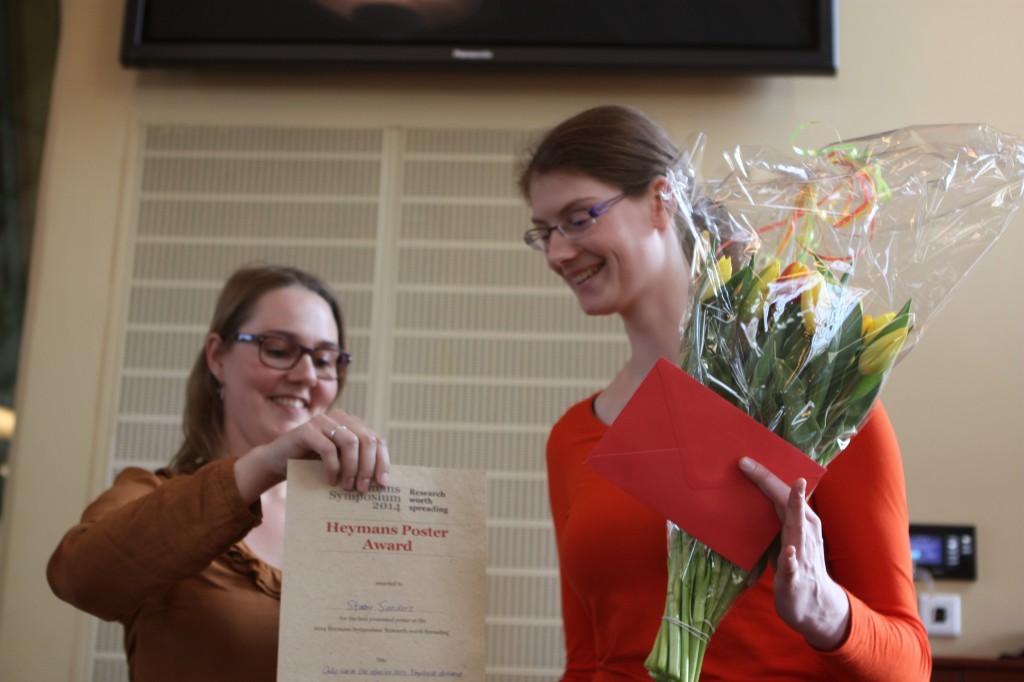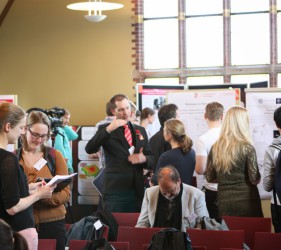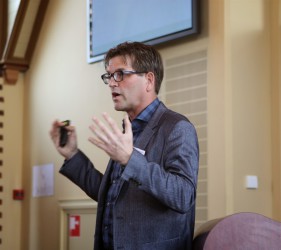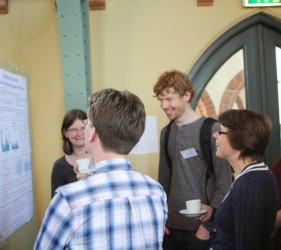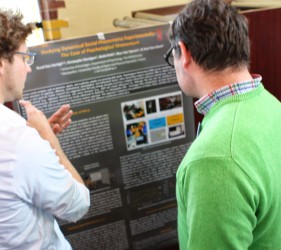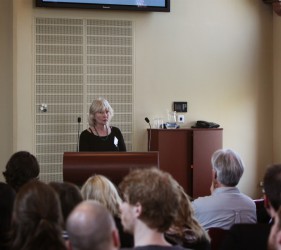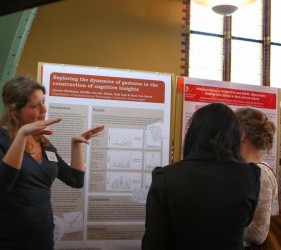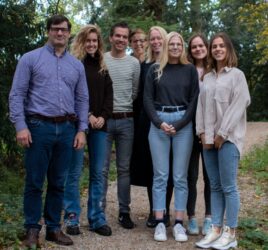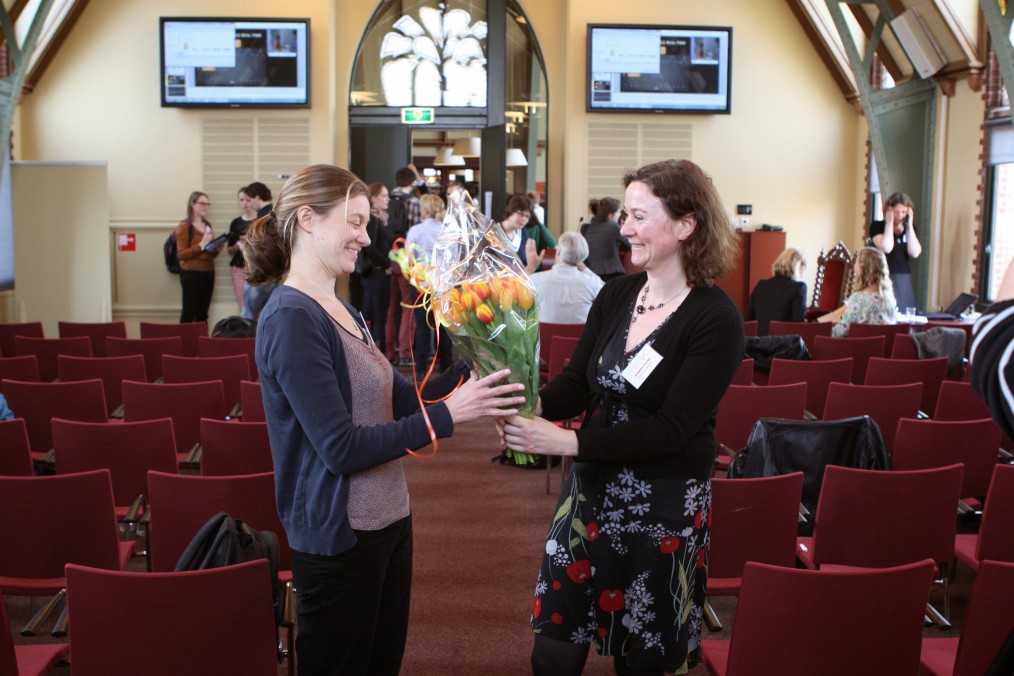
Research worth spreading! A postscript on the Heymans Symposium
The afternoon was introduced by the current Research Director, Ernestine Gordijn. She highlighted a major goal of the Heymans Symposium: informing students and staff about the work of colleagues in the Department and thereby providing opportunity for new collaborations. This is also one of the goals of Mindwise and so I became even more eager to hear the ten selected speakers.
Jacob Jolij (Experimental Psychology) immediately captured the audience’s attention. Firstly, he announced he would not be using any slides! Secondly, he started talking about phantom vibration syndrome — which reminded several people to silence their cell phones. After moving on to phantom earthquake syndrome (now epidemic in the Groningen province, due to gas production) he swiftly introduced the audience to one of his research interests: how does your brain make you see a face when other people tell you there is one to be seen, but in fact there isn’t? Jacob was quickly able show that the brain is very good at making you believe you know your world but that these beliefs are not necessarily grounded in reality.
“Is there a phantom earthquake syndrome in Groningen?”
Faulty beliefs were also the topic of the talk by Peter de Jong (Clinical Psychology). He started with an example that got people thinking about their beliefs about Groningen being a nice place to live. He then discussed the role of beliefs in reasoning about one’s own competence in relation to that of others, and showed that people diagnosed with social phobia make significant reasoning errors with respect to their competence. In the end Peter argued that while the belief biases that can explain such reasoning errors may underlie the development of anxiety disorders such as social phobia, psychological interventions might in the future be able to modify these biases.
Saskia Kunnen (Developmental Psychology) clearly explored how to best spread her research. She announced, “I understand that (these) talks should start with something easy to understand,” and proceeded to show that indeed, developmental psychology is about development. More specifically, Saskia brought home the message that development is really about processes of change within individuals, rather than across groups. She showed that more or less random events occur all the time and may lead one person to develop in a very different way than another person, even though they started off at a similar level.
“Comparing yourself too much with others may make you unhappy. Focus more on how to improve yourself.”
After the first break Nico van Yperen (Organizational Psychology) tried to convince the audience that golfing is fun – because it’s possible to get better at it. He then presented the goal pursuit model and pointed out that people might evaluate their achievements in terms of personal performance or by comparing themselves with others. Nico showed that people who engage in social comparison tend to be unhappy about their achievements. Nevertheless, people often compare themselves with others, and only when they are reminded that their goal is to improve themselves do they report feeling good about their achievements.
Casper Albers (Psychometrics and Statistics) was next and he offered himself up for hire. First he argued that, in this age of smartphones, smart grids, and “a lot of things that start with smart”, researchers should conduct more studies in daily life, outside of the laboratory. Then he promoted longitudinal, measurement-intensive studies that generate lots of data. And then he talked about what was definitely on my mind – how to analyze these data. According to Casper, dynamic linear modeling is the answer: “It’s difficult to learn but you can overcome this by learning it.” That sounded very hopeful, so after the symposium I sent him an email to take him up on his offer.
From statistics we moved on to semen, sweat, and saliva. Charmaine Borg (Clinical Psychology) presented some of her dissertation work on why people often find these body fluids much less disgusting in a sexual context. Charmaine’s Ph.D. thesis, which she defended last December, was titled Sex, disgust, and penetration disorders. In her talk she pointed out that while the popular media were quick to pick up on the sex and disgust part, much less attention has been given to the relevance of her work for women who experience pain during intercourse or are unable to have intercourse altogether.
“Isn’t it surprising that most people do not find sexual contact disgusting?”
Stephan Schleim (History and Theory of Psychology) argued that psychology cannot be reduced to neuroscience and that neuroscientists can benefit from the input of psychologists. More specifically, he stated that the field of human neuroscience, which relies heavily on imaging methods, has often neglected the impact of the environment on the functions of the brain. Stephan reminded the audience that not everyone with damage to the orbitofrontal cortex becomes aggressive and that not everyone who is aggressive has damage to the orbitofrontal cortex.
After the second break the microphone went to Judith Rachl (Organizational Psychology). She is studying nonverbal behavior and talked about something that is indeed hard to put into words — why do we “click” with some people, and not with others? Judith presented data about the effects of mirroring someone’s poses and gestures on how much this person might like us.
Reint Geuze (Neuropsychology) continued with a very different topic, lateralization of brain functions. He shared his interest in the question of why evolution favored division of labor between the brain’s hemispheres. Lateralization typically implies that verbal functions (e.g., language production) are organized in the left hemisphere and spatial functions (e.g., mental imagery) are organized in the right hemisphere. Reint showed that people with a typical organization are better at performing two tasks simultaneously than people with a non-typical lateralization. This might offer an evolutionary benefit.
“We don’t often think about it, but for babies these are milestones: learning to sit and learning to walk.”
The final speaker of the day was Heidi Meindertsma (Developmental Psychology). She talked about the importance of studying young children in real time, rather than over longer time periods. Two major milestones in a baby’s life are learning to sit and learning to walk. Generally several months pass between the two, and Heid pointed out that while people usually remember the milestones, they know very little about what happened in between. She went on to show that we can actually learn a lot from studying this time period, because there is a lot of variability in behavior just before the next milestone happens.
Heidi’s talk concluded the symposium, and I want to conclude this piece by reminding you that there were several prizes to be given away. The winner of the Snijders-Kouwer Award was Jonna Brenninkmeijer. Her winning journal article is titled Neurofeedback as a dance of agency and was published in BioSocieties. Stacey Sanders took home the Poster Prize with Only harm the abusive boss: employee deviance as a response to abusive versus ethical supervision and the mediating role of anticipated guilt. Congratulations and I am looking forward to next year’s symposium! Thanks to Selwyn Renard, Angela Ruepert, and Stefanie de Vries for organizing.


